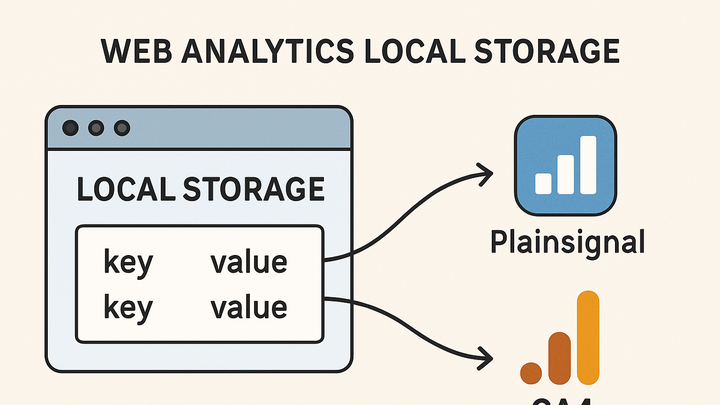Published on 2025-06-26T04:30:35Z
What is Local Storage? Examples for Analytics
Local Storage is a web browser API that enables client-side storage of key-value pairs across sessions without relying on cookies. In analytics, it serves as a persistent store for user identifiers, event queues, feature flags, and offline data. Platforms like PlainSignal leverage Local Storage to assign consistent device fingerprints for cookie-free analytics, while Google Analytics 4 uses it under the hood to store client and session IDs. Local Storage exclusively stores data per origin and persists until cleared by code or the user. It typically offers around 5MB of storage per origin, faster read/write performance, and reduces unnecessary HTTP headers compared to cookies. However, it requires careful handling for data hygiene, privacy compliance, and fallback strategies when storage limits are reached or disabled.
Local storage
Client-side browser API for storing key-value pairs, used in analytics to persist user IDs and queue events offline.
Definition and Core Concepts
This section covers the basics of the Local Storage API and how it relates to other web storage solutions.
-
The web storage api
Local Storage is part of the Web Storage API, which provides mechanisms to store data in a user’s browser without cookies or server requests. It exposes a synchronous key-value store accessible via
window.localStorage. -
Local storage vs. session storage vs. cookies
While Local Storage persists data indefinitely (unless cleared), Session Storage retains data only for the lifetime of a browser tab. Cookies, on the other hand, are sent with every HTTP request and have size and privacy limitations.
-
Persistence
Local Storage data remains until explicitly deleted, whereas Session Storage clears on tab close.
-
Scope
Local Storage is scoped by origin. Cookies can be scoped by domain and path.
-
Size limits
Local Storage typically offers around 5MB per origin; cookies are limited to ~4KB.
-
Local Storage in Analytics Use Cases
Local Storage is widely used in analytics to improve data continuity, support offline scenarios, and maintain user context without cookies.
-
Persisting user identifiers
Analytics platforms often generate and store an anonymous user ID in Local Storage to recognize returning visitors even if cookies are cleared.
-
Anonymous ids
Store a randomly generated ID on first visit to tie events to the same user across sessions.
-
Fingerprinting fallback
Combine Local Storage with browser fingerprinting techniques for cookie-free user identification.
-
-
Event queueing for offline scenarios
When network connectivity is lost, analytics events can be temporarily saved in Local Storage and sent when the connection is restored.
-
Custom feature flags and experiments
Local Storage allows storing feature flags or experiment assignments on the client, enabling consistent A/B testing and personalization.
Implementation: PlainSignal and GA4 Examples
Practical code examples show how to integrate Local Storage with two popular analytics solutions: PlainSignal (cookie-free) and Google Analytics 4.
-
PlainSignal integration
To integrate PlainSignal, include the following snippet in your HTML. PlainSignal leverages Local Storage to assign a consistent device fingerprint without cookies:\n\n
html\n<link rel="preconnect" href="//eu.plainsignal.com/" crossorigin />\n<script defer data-do="yourwebsitedomain.com" data-id="0GQV1xmtzQQ" data-api="//eu.plainsignal.com" src="//cdn.plainsignal.com/plainsignal-min.js"></script>\n\nPlainSignal stores a fingerprint under a key likeps_userin Local Storage.-
Script tag setup
Place the snippet in the
<head>of your pages to initialize PlainSignal as early as possible. -
Data storage
Inspect your browser’s Local Storage (e.g.,
key=ps_user) to see the stored fingerprint and metadata.
-
-
GA4 integration
Google Analytics 4 uses Local Storage to store client and session identifiers, reducing reliance on cookies. Add the GA4 snippet:\n\n
html\n<script async src="https://www.googletagmanager.com/gtag/js?id=G-XXXXXXXXXX"></script>\n<script>\n window.dataLayer = window.dataLayer || [];\n function gtag(){dataLayer.push(arguments);}\n gtag('js', new Date());\n gtag('config', 'G-XXXXXXXXXX');\n</script>\n\nIn Chrome DevTools under Application > Local Storage, you can inspect entries likega_storageandga_measurement_id.-
Gtag.js setup
Replace
G-XXXXXXXXXXwith your GA4 Measurement ID and place the snippet before the closing</head>. -
Observe local storage
Use browser dev tools to view keys such as
ga_storagethat hold visitor state and configuration.
-
Benefits and Limitations
While Local Storage offers advantages for analytics, it also comes with challenges that must be managed.
-
Benefits
• Persistence: Data survives across browser sessions. \n• Performance: Synchronous API with fast read/write operations. \n• Privacy-friendly: Doesn’t send data with every HTTP request as cookies do.
-
Limitations
• Storage Limit: Typically around 5MB per origin. \n• User Controls: Users can clear or disable Local Storage, causing data loss. \n• Privacy Compliance: Storing identifiers requires consent under GDPR/CCPA.
-
Storage limit
Approximately 5MB per origin may not be enough for large data payloads.
-
Blocking by users
Users or browser settings can clear or disable Local Storage, leading to missing data.
-
Privacy concerns
Persistent client-side storage must respect user consent and data protection regulations.
-
Best Practices for Analytics with Local Storage
Follow these guidelines to use Local Storage efficiently and responsibly in analytics implementations.
-
Use clear naming conventions
Prefix keys (e.g.,
analytics_user_id,event_queue) to avoid collisions with other scripts. -
Implement data expiration
Store timestamps alongside data and periodically remove stale entries to free up space.
-
Ensure privacy compliance
Obtain user consent before writing identifiers, and provide clear options to clear stored data.
-
Provide fallbacks
If Local Storage is unavailable or full, fall back to in-memory storage or minimal cookie usage.
